bunip
Member
I'd suggest some care in pulling the plate forward as springs are stainless very thin but hard so they better brake then deform. Would you know how I know this?
I would suggest to follow it if you have the tools for it, DSLR, technical film and flashlight. For the other method you need a ground glass of a precise dimension film gate.In another thread, https://www.photrio.com/forum/threads/folder-distance-scale-origin-point.160778/page-2#post-2174708 user alexvaras proposes just this morning the same method as I did in post #17 above https://www.photrio.com/forum/threa...much-of-my-nettar-515-16.167101/#post-2174450, maybe slightly better because he has the paper in place, in case it would make a difference.
When I want to know if it fits I measure the pressure plate with a calliper and take this to the film gate and see how it fits, some cameras the film contact point can be either on the vertical rollers or the horizontal rails where they should be (my guess).On second thoughts, I'm not sure I understand. When the pressure plate is supposed to be pressed against the film gate, the camera is closed. Unless you remove the lens, I don't understand how you can check whether the pressure plate is pressing correctly or not.
Not too carefully! You need to produce some permanent deformation of the leaf springs to achieve something.
For the other method you need a ground glass of a precise dimension film gate.
... I don't understand how you can check whether the pressure plate is pressing correctly or not.
...
Not too carefully! You need to produce some permanent deformation of the leaf springs to achieve something.
OK. Then it is not independent evidence. Meaning independent from the foreground twigs being sharper than the distant landscape in your first photo. I misunderstood that you somehow had observed that in operating conditions there was a gap between the pressure plate and the film gate.I can't directly measure it; I can only infer that the plate does not hold the film as far forward as it needs to be.
So, the most obvious hypothesis --bad calibration of the lens focus-- should be the prime (but not only) suspect.But still, better safe than sorry. Try the following: with no film in the camera, watch carefully through the red window the corresponding hole in the pressure plate, or a piece of paper taped on the hole where the backing paper should be, while you close the camera; do you see the pressure plate being pushed back when it come against the film gate?I am suspicious of my Nettar's pressure plate: it seemed to be pressed flat against the back, with the springs exerting little pressure. I can actually pull it forward a bit.
If with this test you want to see how far the pressure plate goes back it's a good idea, I have done it before, it gives you the point if the pressure plate is doing its job or there is somethig to be corrected.OK. Then it is not independent evidence. Meaning independent from the foreground twigs being sharper than the distant landscape in your first photo. I misunderstood that you somehow had observed that in operating conditions there was a gap between the pressure plate and the film gate.
So, the most obvious hypothesis --bad calibration of the lens focus-- should be the prime (but not only) suspect.But still, better safe than sorry. Try the following: with no film in the camera, watch carefully through the red window the corresponding hole in the pressure plate, or a piece of paper taped on the hole where the backing paper should be, while you close the camera; do you see the pressure plate being pushed back when it come against the film gate?
For those watching this thread who might think I'm splitting hairs or doing too much theory: false hypotheses, especially implicit, can lead to large loss of time and/or failure. How do I know?
...
Try the following: with no film in the camera, watch carefully through the red window the corresponding hole in the pressure plate, or a piece of paper taped on the hole where the backing paper should be, while you close the camera; do you see the pressure plate being pushed back when it come against the film gate?
..
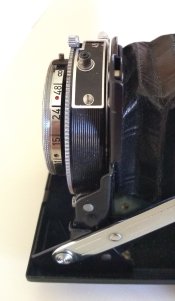
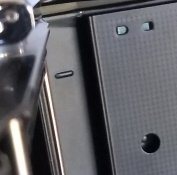
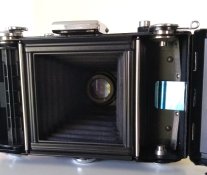
Good.Ok, I did that and do see the paper flatten; I also notice what I believe is more resistance when closing the back.
Beware! I just checked on my Nettar, and I see the same as on my S.Ikonta, as I already mentioned: the rollers are higher than the film rails (I mean of course the inner part, extending over the width of the film). See post #17 https://www.photrio.com/forum/threa...much-of-my-nettar-515-16.167101/#post-2174450. So using a ground glass + loupe I would be unsure where is the plane of the film. I would again recommend the method proposed by alexvaras and myself; see post #24 https://www.photrio.com/forum/threa...much-of-my-nettar-515-16.167101/#post-2174717It seems to me that even if the plate pushes harder than necessary against the gate, the film will always be properly aligned along the flat "rails"
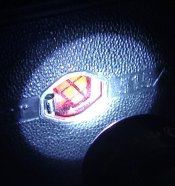
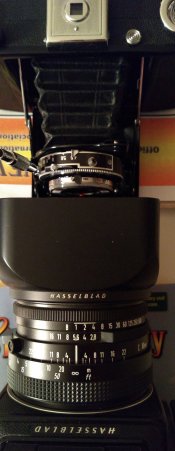
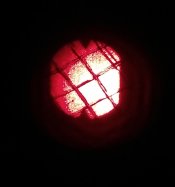
As far as the crossed lines are facing the lens, yes, it should be fine.Success! (I think)
So for this experiment I placed "film" where it would go across both sets of rollers and where the pressure plate would press this "film" forward.
I actually bent the springs a bit more to increase the pressure. I also learned how to put the plate back on properly, since it popped off. At first it was a bit of a mystery how to get the springs into all four slots at once. Anyway, it's all correct now.
I placed a crosshatch pattern on the film so that I could illuminate it from behind with a strong light through the red window:
View attachment 222574
This is my test setup:
View attachment 222575
Here is a view through the Hasselblad. I checked it with the magnifier in the viewfinder as well. The crosshatch pattern was perfectly sharp. If it looks soft here, it's because I had to focus my phone's camera and it may not be perfect.
View attachment 222576
So, I think my Nettar is good now.
...
But have you done any other thing to the camera than increasing the pressure done from the film plate?
Sounds good then, give it a try and let us know, the worst scenario would be the previous collimation was not on the correct position were the film lays and it can be corrected.No. But I believe that before yesterday, the plate was exerting little or no pressure on the film.
Success! (I think)
Good.
Beware! I just checked on my Nettar, and I see the same as on my S.Ikonta, as I already mentioned: the rollers are higher than the film rails (I mean of course the inner part, extending over the width of the film). See post #17 https://www.photrio.com/forum/threa...much-of-my-nettar-515-16.167101/#post-2174450. So using a ground glass + loupe I would be unsure where is the plane of the film. I would again recommend the method proposed by alexvaras and myself; see post #24 https://www.photrio.com/forum/threa...much-of-my-nettar-515-16.167101/#post-2174717




sorry for hijacking^^, as an expert for folders, what do you think about Mamiya Six folder, I`m somewhat fascinated by the fokus mechanism.It's difficoult to say if your camera is in the mean situation of every Novar 75mm lens or not. I have hundreds of folding cameras and I see that every one is different; if I test 4 samples from the same model, same lens, I'll find different results. I have so many cameras because the more you have the better you can source. Take also into account film flatness that sometimes play a big bias from time to time as you could wind your film in different ways and at different times. I wouldn't waste time and film with a novar; these are cheap and you can get a decent tessar or tessar-like (better two) for 100-150 euros each. there you'll see sharpness and have a lot of fun, but I never saw anything similar to modern lenses sharpness (say planars, xenotars or the japanese similars) even with agfa super isolette, voigtlander bessa II (heliar lens or Skopar) or super ikontas.
| Photrio.com contains affiliate links to products. We may receive a commission for purchases made through these links. To read our full affiliate disclosure statement please click Here. |
PHOTRIO PARTNERS EQUALLY FUNDING OUR COMMUNITY:  |


